Last Friday, NOVA colleague Victor Zabielski and I traveled down to Richmond, Virginia, to meet up with Chuck Bailey of the College of William & Mary, and do a little field work on the rocks exposed by the James River.
Our destination was Belle Isle, a whaleback-shaped island where granite has been quarried for dimension stone for many years. The island has also served as a Confederate prison for captured Union soldiers during the U.S. Civil War, and later for various industries. Today, it is preserved as park land, utilized by a wide swath of Richmond’s populace for recreational activities, both licit and non.
Fortunately, a large area of the James’ river bed south of Belle Isle is kept relatively dry by a long low diversion dam upstream. As a result, there are some mighty fine horizontal outcrops of rock:
The dam fed water into a hydroelectric power generation station, but that station has been abandoned for some time now:
The power plant dam has yielded enough exposure that some bedrock mapping is possible for those with the curiosity and fortitude to attempt it. Here’s a simplified geologic map of the area, authored by Chuck and his student James McCulla:
So you can see that most of the area is covered by sedimentary deposits of both modern and early Cenozoic vintage. Our goal, however, was the more interesting stuff beneath that. (All due respect to my sedimentological colleagues; the Coastal Plain just doesn’t get my juices flowing like ‘crystalline’ rocks do!)
So here’s what we came to see, the Petersburg Granite:
This is an Alleghanian pluton, ~320 Ma, and quite large: it extends for tens of kilometers north and south (Petersburg, the namesake locality, is to the south). It disappears beneath the Coastal Plain to the east, and beneath the Richmond Basin (a Triassic rift valley) to the west.
You can see from the photo above that in some places the Petersburg Granite is massive and equigranular, and in other places it’s “foliated,” with long dark lines running through it. These lines are schlieren, curtainlike zones of differing mineral ratios: more mafics than felsics, for instance. The schlieren (German for “lines”) are usually interpreted as magmatic flow structures as higher-temperature-crystallizing mafic crystals raft together in a more felsic flow. At Belle Isle, the schlieren are steeply dipping and trend NNE.
In places, there were also pegmatite bodies that were concordant (~parallel) with this overall magmatic fabric. Here’s an example of that texture:
And here’s a really big crystal of K-feldspar set amid finer-grained granitic groundmass. I guess you could call this a “megacryst”:
Another thing we saw a lot of were dark-colored inclusions in the granite. These were dark due to lots and lots of biotite mica in them. Here’s an example; notice how the schlieren wrap around it:
And another, with its long axis oriented parallel to the strike of the schlieren, suggesting alignment in the magma chamber before the granite set up:
How should we interpret these mafic inclusions? Are they xenoliths; fragments of country rock that were broken off and included in the intruding granitic magma? Or do they represent a plutonic emplacement process — perhaps an earlier stage of crystallization, or an immiscible bolus of mafic magma floating like a lava lamp blob in the surrounding felsic melt? When they’re fine grained and lacking internal structures, as with the above examples, it’s really hard to make that call.
On the other hand, this one clearly shows fragmentation along the right edge, suggesting to me that it was a coherent xenolith at the time the enveloping granite set up into solid rock:
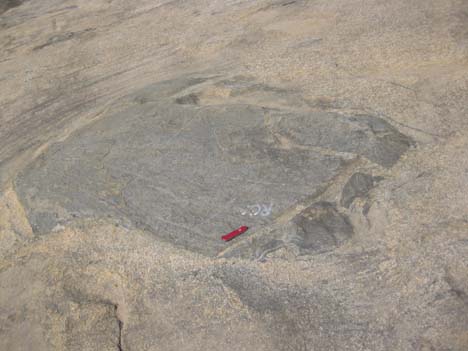
That rules out the fluid-blob-within-another-fluid hypothesis, but is it country rock?
This one suggests that it is indeed country rock, as it is both foliated and kinked internally:
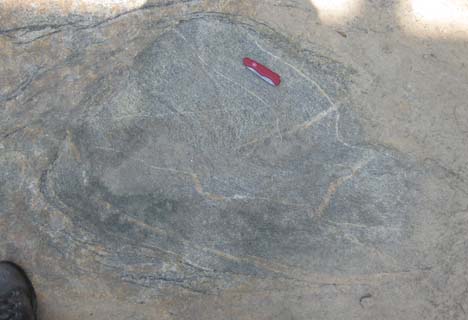
Here’s a heart-shaped inclusion which also suggests that it is a genuine xenolith. As with the previous example, it displays internal foliation that has been folded:
Victor ponders these xenoliths, as well as a dense clot of biotite (dark steak next to the yellow field notebook – not Chuck’s shadow, but parallel to it and closer to the photographer’s vantage point):
The photo above also shows how the schlieren wrap around these xenoliths. Here’s an example where the schlieren “tails” leave the xenolith “higher up” on the left side than the right side, suggesting a sinistral (counterclockwise) sense of magma-flow kinematics:
This one is a beauty. It’s almost perfectly circular in cross-section, though with little flanges coming off the upper left and lower right. However, the “tails” are both on the same side of the xenolith, so I don’t really feel like I’ve got a good bead on its kinematics:
A few more shots of these xenoliths:
This one is a cool one…
… because when you zoom in on the edge, you can see it has some ptygmatic folding inside it. Like the foliation and the broader folding we observed earlier, this internal structure suggests that these are genuine xenoliths; fragments of pre-deformed country rock.
Another xenolith, also showing this internal deformation of ptygmatically-folded granite dikes:
…And this one shows internal boudinage:
Chuck examines a small vertical surface to get a sense of what these xenoliths are doing in the third dimension:
This next bit was a real treat for me. It’s no secret that I’m a huge fan of boudinage, that brittle-ductile phenomenon that separates a more competent rock type into sausage-like chunks while a less competent rock type flows into the void between those chunks. Here’s some schlieren that evidently became thick enough slabs of biotite that they were able to behave as semi-coherent sheets, subject to boudinage:
…Not only that, but if you back out and follow these boudinaged schlieren along strike, you can see that they are folded, too! Check out these sweet isoclinally folded, boudinaged schlieren:
Biotite-rich inclusions which I interpret as similar “scraps of schlieren” which became entrained in later magmatic flows:
While everything I’ve talked about so far has been concordant with the dominant schlieren orientation (and thus reflective of main-stage magmatic flow in the Petersburg Granite), there are also some discordant features, like dikes, which cut across the regional fabric.
Here, for example, is an aplite dike:
Aplite is very felsic and displays a “sugary” fine-grained texture. This aplite dike is quite a nice feature, traceable over a long distance across the outcrop. We followed it a ways to a spot that Chuck was particularly eager to show us: a spot where the aplite dike crosses an earlier pegmatite dike, and then both dikes are cut by a right-lateral fault and a fracture set which parallels the schlieren. Check it out in outcrop (note the positive relief on the aplite dike):
And here’s a sketch of this outcrop (above photograph from the perspective of the lower right corner):
What a fine spot to bring students and have them suss out the order of events! First came the massive granite, then the pegmatite dike, then the aplite dike, then sometime later under very different P/T conditions, the rock was fractured and we get fractures: some of which show an apparent right-lateral offset (faults; oriented ENE), and others where no offset is apparent (joints). This second set appears to be utilizing the schlieren as zones of weakness, as it is parallel to the schlieren (NNE) and often occurs along their biotite-rich traces.
Whether the faulting or the jointing came first is a question we’ll examine in the next episode…

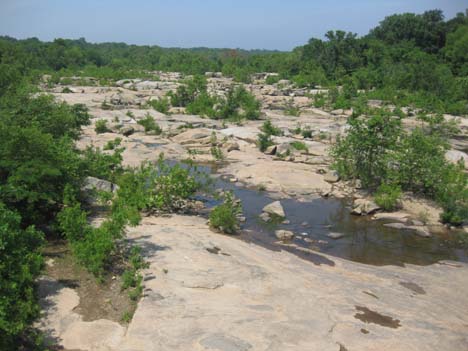
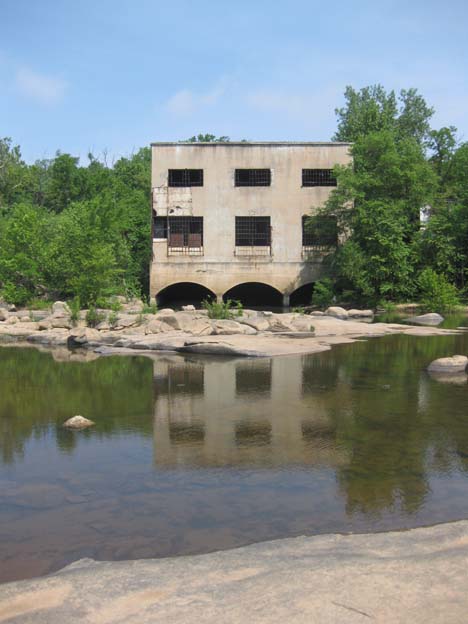
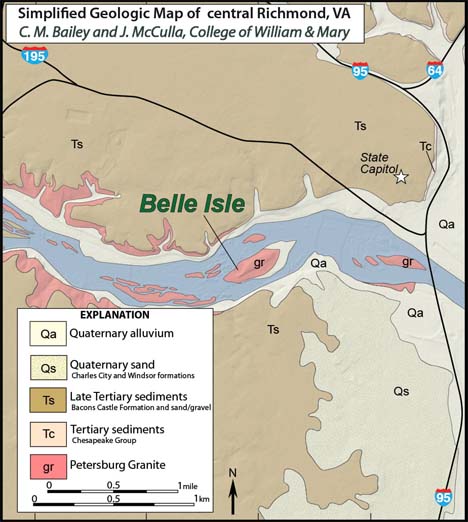
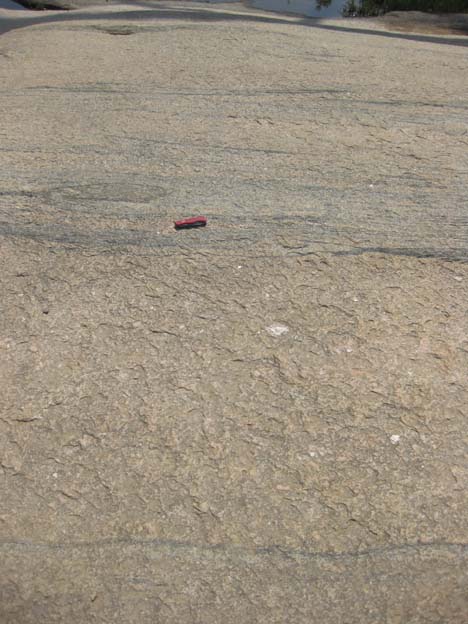
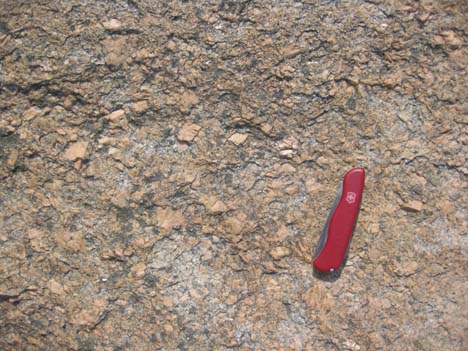
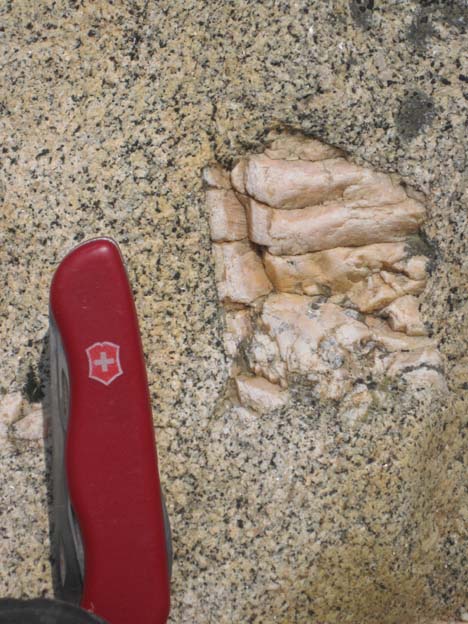
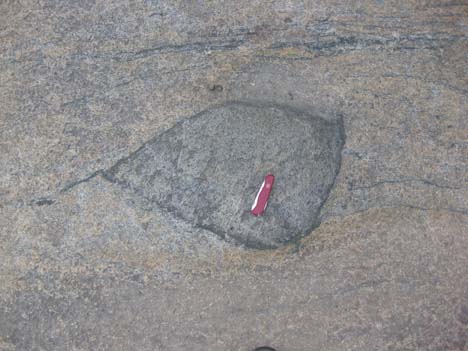
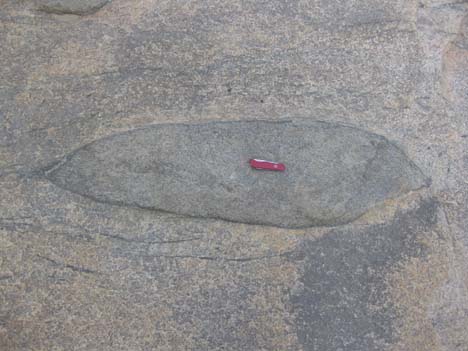
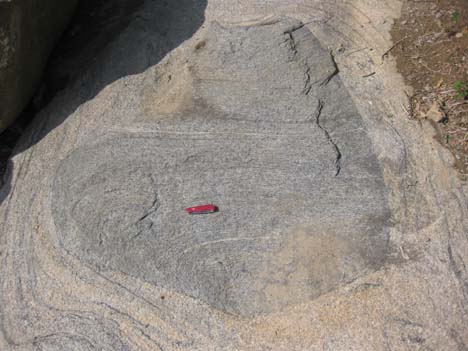
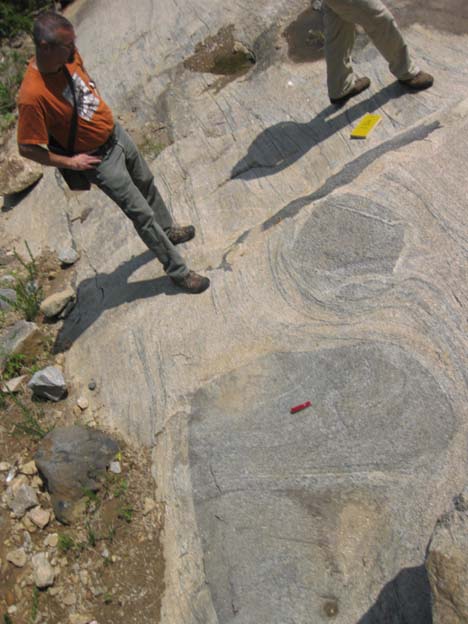
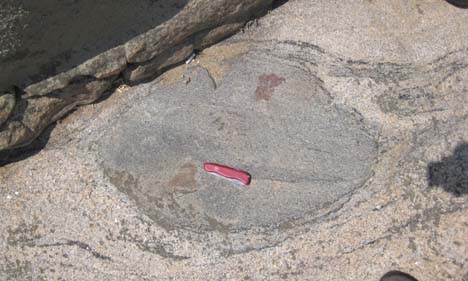

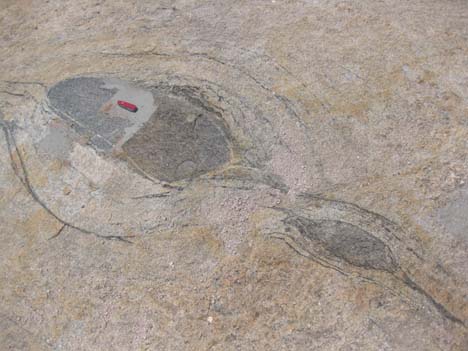
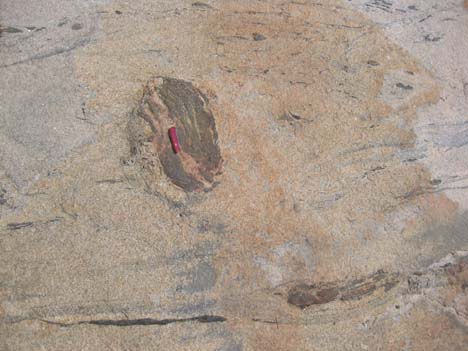
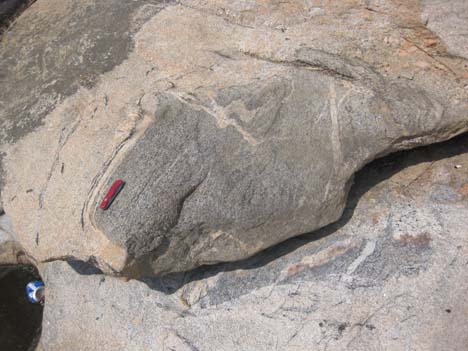
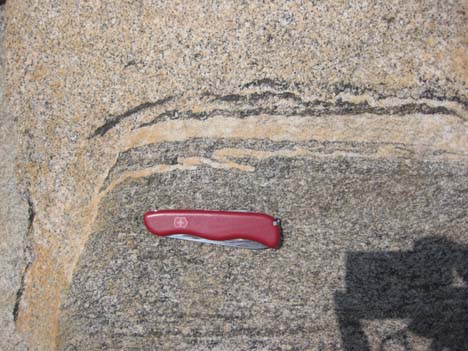
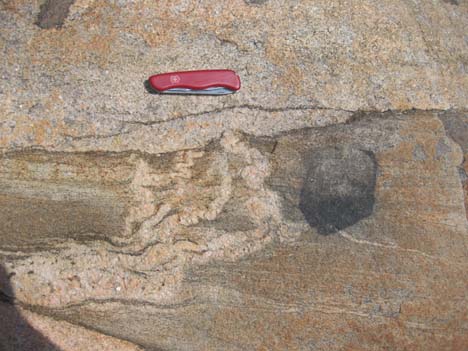
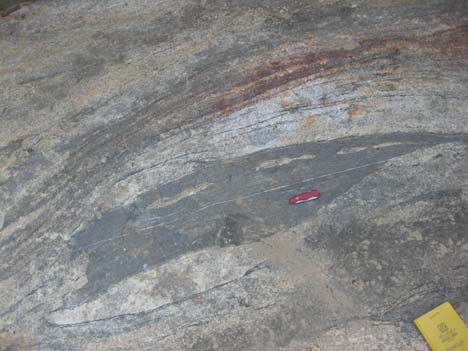

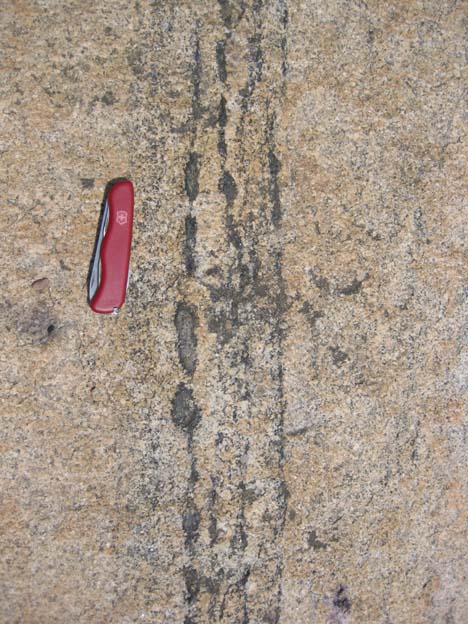
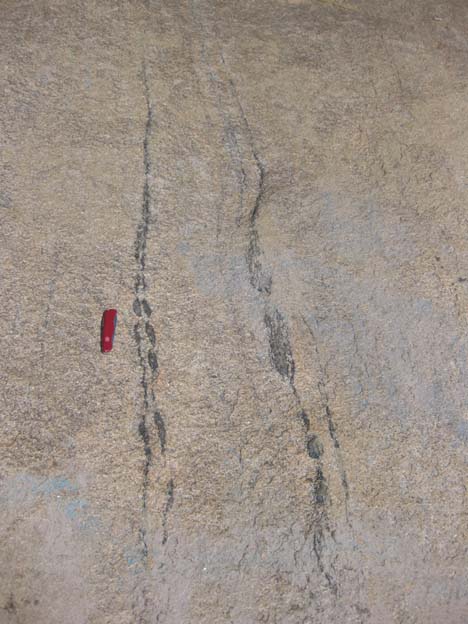
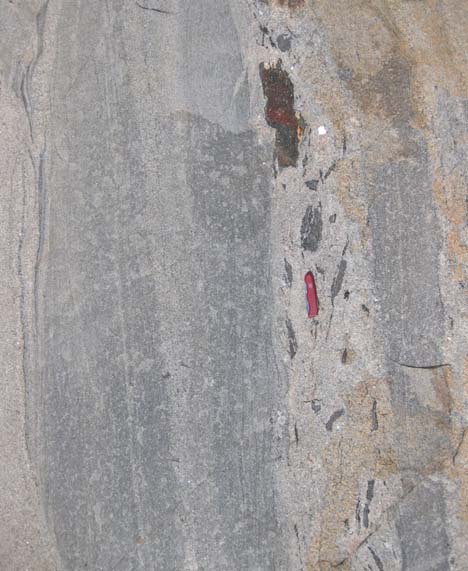

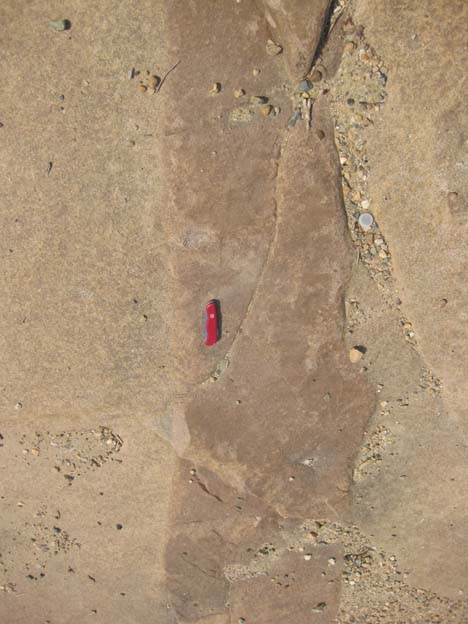
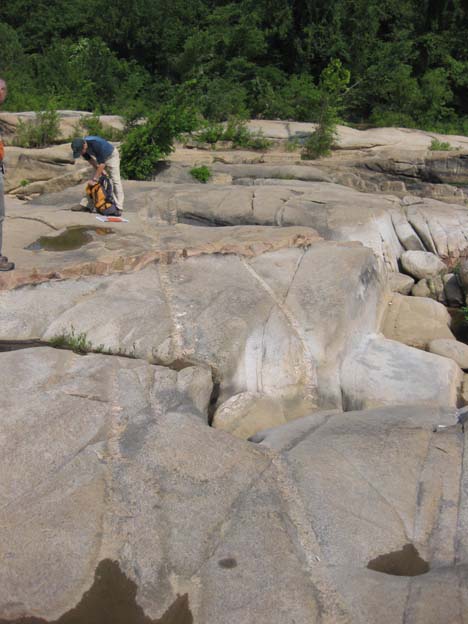

Great photos! I remember going out there as a freshman and seeing some of these things, and I always thought they were really cool.
And hey, Chuck has a new shirt! Times are a-changing.
When I lived in Richmond I would go by Belle Isle all the time, and had no idea any of this was there. In my defense I was yet to take a single Geology class.
Now I have a good reason to go back.
What are the chances that this is not a granite. Do you think that you could be looking at clasts instead of xenoliths? Maybe you are looking at relict sedimentary structures and bedding that is wrapping around exotic blocks.
Think melanges and olistostromes (Hsu’s 1974 paper) . Pebbly mudstone. Then overprint with pervasive shearing and local granitization.
There are a lot of rocks like this in the Maryland Piedmont between DC and Balto. in the Sykesville gneiss and Wissahickon. Look along Northwest Branch, Paint Branch (Near Naval Surface Weapons lab or whatever it is called now), Sligo Creek from the fall line westward. I seem to remember them in Rock Creek Park too, along Klingle (a stream) and in the streams in northern VA near Chain Bridge. The outcrops were not nearly this good but the range of massive vs layered can be seen if you cover enough stream beds.
I did a Masters Thesis on stuff that looked like this.
Hi Pamela!
I think the chances of the Petersburg Granite not being a granite are very low. I’m familiar with the Sykesville Formation (once interpreted as a gneiss, then as a sedimentary melange, and now –by some– as meta-ignimbrite), and I’m also familiar with granitoid plutons in the Sierra Nevada. The Petersburg Granite definitely is a granite: visiting it was like returning to my own master’s thesis haunts along the Sierra Crest. In my experience, I’d say that the most parsimonious interpretation would be a felsic pluton with xenoliths.
C
Am loving this.